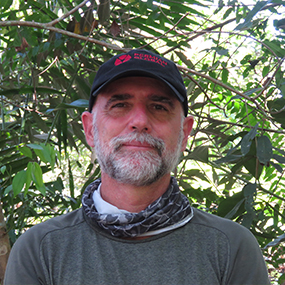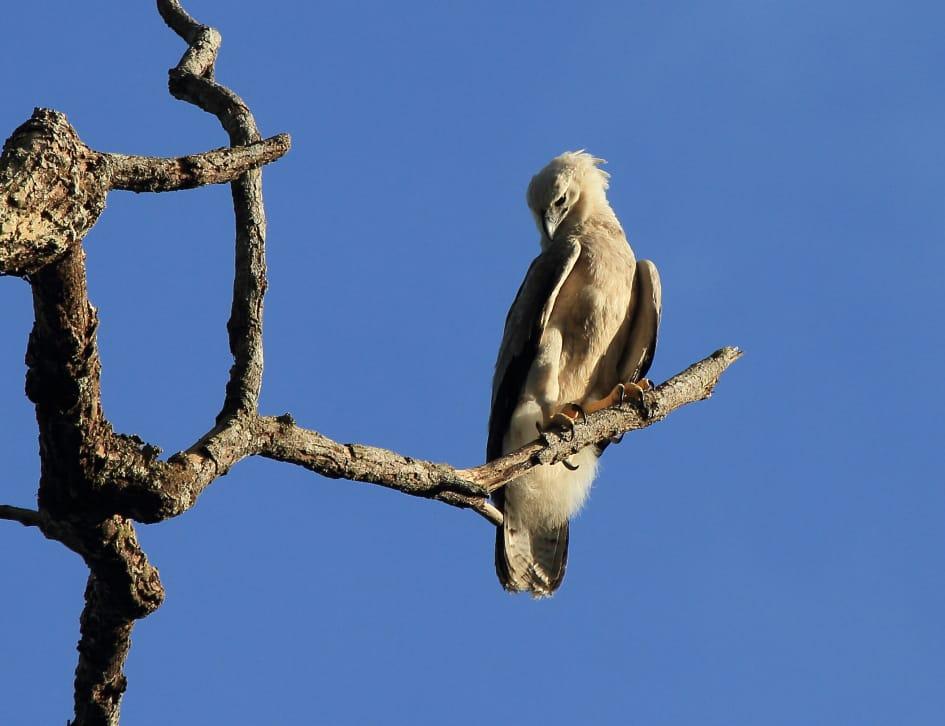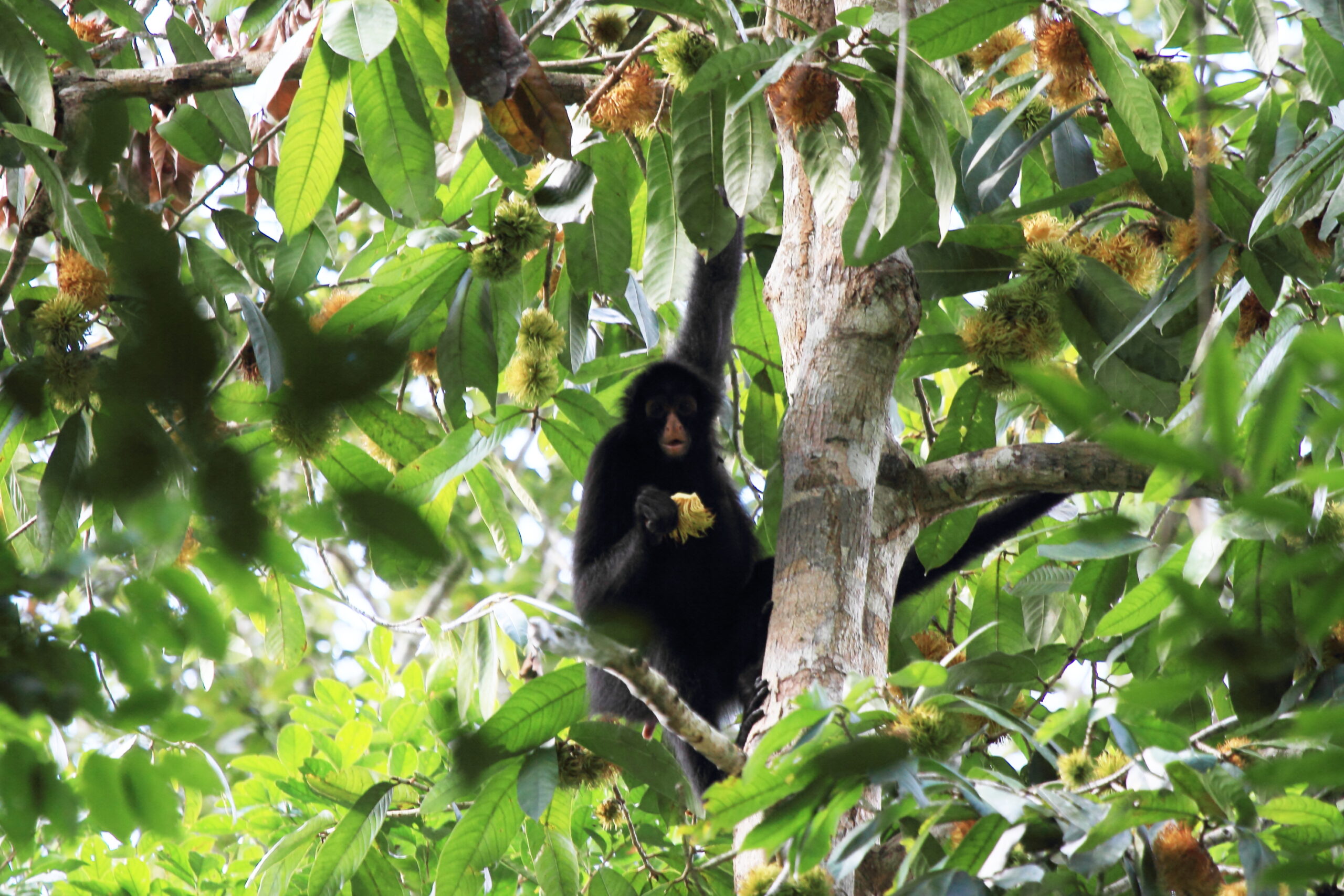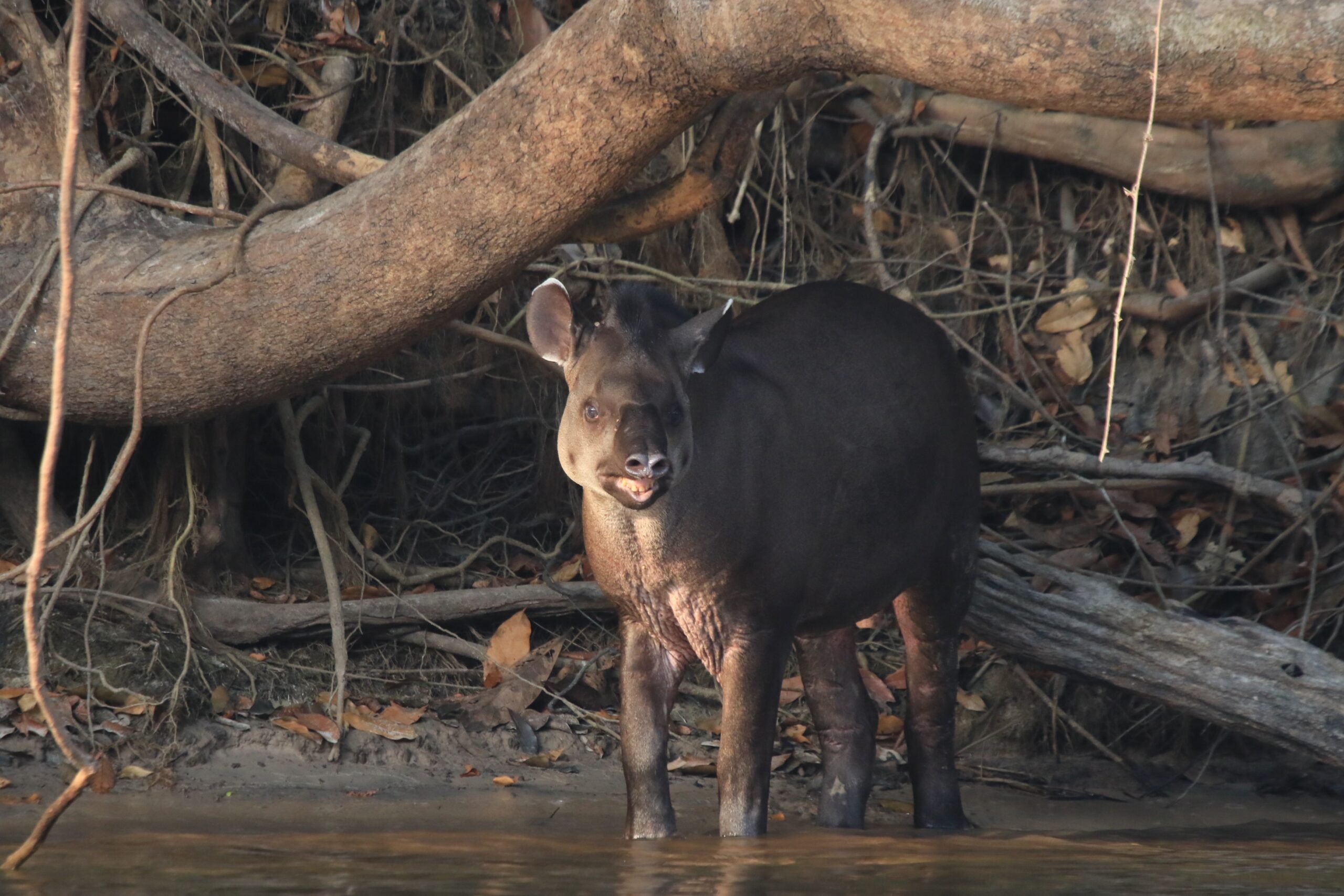
by Dr. Fabio Olmos, Head of Technical & Scientific Support, Permian Brazil
October 17, 2023Last year my good friend and colleague Juan Chang gave a TEDx Talk, where he told the story of the Brazil nut tree (ertbholletia excelsa or ‘castanheira’, Portuguese for chestnut tree) and how it relies on a rodent called agouti to gnaw through the tough outer casing and plant the seeds for the next generation.
Huge chestnut trees are scattered throughout the forests of the Rio Cautário State Extractive Reserve, where the local community is developing a forestry carbon project with Permian Brasil.
Resex Rio Cautário is a forest oasis in Rondônia, one of the most deforested regions of the Brazilian Amazon. As Juan explained, most, if not all, of these 40 to 45m tall giants began their life inside a very hard woody fruit (locally known as a hedgehog) where they would have died, eaten by insects or fungi, if not for the rodent.
Agoutis are widely distributed in tropical America, where there are around 13 species, and which feed mainly on fruits and seeds. As Juan told us, agoutis are the only creatures with the sharp teeth and dedication capable of gnawing through the hard shells of hedgehogs to remove the nuts (8 to 24 per hedgehog) inside.

Saved for later
Agouti also have the habit of burying seeds to eat them later, a habit shared with other rodents and birds such as rooks. Memory isn’t perfect (I imagine an elderly agouti must be especially flighty) and, as Juan pointed out, agoutis may, at times, lose their nuts.
Agoutis are prey to many species, including the bushmaster (Lachesis), a highly venomous pit viper found throughout Central and South America with earthy ochre colouring and dark patterning; the mysterious bush dog (speothos venaticus), a small, near-threatened canine species; the jaguar (panthera onca); and the magnificent harpy eagle (harpia harpyja), which is amongst the largest raptors in the world. Each agouti that becomes a meal leaves behind a treasure trove of buried seeds that are now free to germinate.

The agoutis play an important role in the seed disperal of other forest giants such as jatobás, tauaris, canimbucas, araparis, angelins, etc., as well as many other smaller species that drop their fruits on the forest floor, including the rubber tree and a variety of palm trees – açaí, bacaba, babaçu, buriti, patauá – used by the locals.
The largest trees in the forest, those with a diameter greater than 90 cm, are only 0.4% of the 21,548 trees we measured in Rio Cautário, but they correspond to 9% of the biomass and carbon stored in the forest’s trees. Chestnut trees represent ¼ of these giants.
In 2013, nuts and rubber collected in the forests of Resex Rio Cautário corresponded to 28% of the income of families living in this reserve. In 2022, these families collected 280 tons of nuts.
It is easy to see how the services of the humble agoutis have a direct positive impact on the lives of the forest and the people. A free service that is not generally valued when eating roast agouti or perhaps agouti in chestnut milk.
Natural benefits
Returning to Juan’s speech, those giant trees will draw in carbon and store it in their growing hardwood trunks and branches. Preventing this carbon from warming the atmosphere and causing problems in the climate, and consequently, for all of us.
This is an invaluable and often overlooked service that will continue for centuries unless some misfortune happens, frequently in the form of someone with a chainsaw or gasoline and matches. More trees die because of people than of natural causes.
Rio Cautário is not a virgin forest. In an Amazon that has seen human populations arriving, leaving, mixing and replacing each other, trees are still recovering from the impacts of agriculture and fire caused by people who lived there long before colonization. Nearby archaeological sites show a continuous human presence dating back more than 6,000 years, as well as agriculture, fires and logging carried out by more recent residents.
Agoutis tend to be more numerous in disturbed or regenerating (or secondary) forests, and it is no surprise that in Rio Cautário our camera-traps have recorded them at all 63 sampling stations.
This is great, as secondary forests are a carbon sink. Young growing trees that absorb carbon dioxide (CO2) from the atmosphere are one of the most effective and cost-effective solutions for mitigating climate change, with the bonus of helping biodiversity and other ecosystem services, especially the hydrological cycle – Amazon rainforests help create the rain that sustains them.
Sowing seeds
The gardening club is much more varied than rodents. In the treetops of Rio Cautário, black spider monkeys (Ateles) and 10 other primate species consume varying amounts of fruit in their diets, swallowing seeds that hitch a ride through their digestive systems, before falling to the forest floor with a dose of organic fertilizer.

Once scattered upon the forest floor, a diversity of species of dung beetles, we still don’t know how many species, make balls of excrement with mixed seeds and bury them some distance away to feed their larvae. Many of these giant forest trees had this modest origin.
The larger the input (and output) the larger the seed an animal can swallow and transport. Spider monkeys, the largest primates in the region, gorge themselves on sweet, fleshy fruits and are important dispersers of trees such as canelas, breus, maçarandubas, araçás and others. Breus are among the most common trees in Rio Cautário.
As a birdwatcher, I also want to mention the feathered club. Larger birds such as curassows, jacus, aracuãs, jacamins, toucans, araçaris and anambés feed mostly on fruits and are well-known seed dispersers. In fact, the relationship between some tree species and particular birds is so close that researchers have shown that there is a rapid evolution in the size of fruits and seeds when larger birds, such as toucans, disappear from a forest area, leaving only small thrushes as available dispersers.
Head gardener
Whilst each of these creatures work hard, the current title of bulk seed disperser goes to the lowland tapir (tapirus terrestris). This 180-300 kg mammal, a member of an ancient lineage with three (perhaps four) species in the Americas and one in Southeast Asia, has a mixed diet that combines foliage and fruits gathered from low branches and the forest floor.
After giant mammals such as mastodons and ground sloths, which lived in the Americas, became extinct some 10,000 years ago due to a combination of climate change, hunting and fires caused by humans (remains were found not far from the Rio Cautário), tapirs are the only large mammal left in the Amazon with the ability to swallow large numbers of seeds from many trees and move them over great distances.
Local names such as abiu de anta, goiaba de anta, araçá de anta, fruta de anta, etc recognise the intimate link between tapirs and many trees.

Years ago, I reviewed the diet of different species of tapir and discovered that there were 35 species of fruit recorded in the diet of this species, until then, little known, which lives in Brazil. This number should be, today, something around 10 times more. I also carried out some experiments showing that species considered to be dispersed by large birds, like the palm Euterpe and the tree Virola (a toucan favourite), are also effectively dispersed by tapirs.
Not only do the seeds swallowed by tapirs remain fully viable after up to 4-23 days moving through the digestive system, but a single dung pile may also have hundreds of seeds waiting to be moved away by dung beetles, rodents or just water flowing downhill. Research has also shown how groupings of some species, such as palm trees, can emerge from tapir latrines.
Furthermore, other researchers have demonstrated that, in the Amazon, tapirs deposit many more seeds in secondary forests compared to primary ones, and like agoutis, they play an important role in their regeneration and diversity.
Group effort
You may have already noticed that the process for a seed, inside a fruit, to become a full-grown tree, includes several steps and several actors with more differences in their characteristics than their number of legs.
These networks of interactions are part of the biodiversity of an ecosystem and understanding them is the work of scientists who study Ecology (like me). Knowledge necessary for us to better manage the natural ecosystems that remain on the planet.
Moving seeds across a landscape is essential for the functioning of native forests so important for storing carbon in our biosphere. Not only that, but regenerating forests like those trying to grow on the millions of hectares of degraded land in the tropics are a comparatively easy win in the fight to keep CO2 concentrations in the atmosphere from exceeding a threshold that makes Earth a challenging planet to live on.
For that to happen, seeds of those big, long-lived, dense-wood trees must be transported. Managers of protected areas and forest carbon projects, such as Rio Cautário, must consider the role of seed dispersers and incorporate their conservation in their business strategy, increasing negative human impacts on them.
Our fault
Unfortunately, most of the large seed dispersers living in the world’s threatened forests are endangered due to habitat destruction and being targets themselves. We are eating, skinning and trading species to extinction and many of the world’s remaining forests have lost key species because we humans have killed every last individual.
Recent research reveals how we and our pets dominate the world to the exclusion of the rest of life.
If all the mammals on Earth, from you to blue whales, from platypuses to your neighbour’s French Bulldog, were stacked and weighed, 36% of this mountain of meat would be humans, 58% domestic animals (mostly cattle), 3.7% whales and other marine mammals, while the remaining ~6,300 species of terrestrial mammals – from microbats to elephants – would correspond to just 1.8%.
And some even say that there is too much land allocated to nature.
All four recognized tapir species are threatened with extinction. The species that still lives in Brazil once occurred throughout South America east of the Andes, from Colombia to northern Argentina, and practically throughout the national territory.
Tapirs were eliminated from much of their historical range, such as the Atlantic Forest and the Cerrado – ecosystems eliminated to make way for sugarcane, coffee, soybeans, corn, cotton and cattle. They went extinct even in national parks and other protected areas because people ate them all, every last one.
On the other side of the world, the Malayan tapir, one of the coolest designed mammals, once occurred throughout Southeast Asia and on the islands of Sumatra and Borneo. Today there are only scattered populations in Thailand, the Malay Peninsula and Sumatra.
The way forward
In the midst of the widespread loss of life on Earth, I prefer to think about action rather than despair, and some initiatives show a way.
Much has been written on “rewilding” of late, which means bringing back what was lost and restoring interactions making ecosystems more diverse, productive and resilient. Efforts validated by research that shows how the loss of major actors, the so-called megafauna, negatively affects the composition of forests, soil carbon stocks and fire regimes.
Tapirs are being reintroduced into two areas where they went extinct long ago to fill the gap in the ecosystem machinery. In the Guapiaçu Ecological Reserve, a private area not far from the city of Rio de Janeiro, previously captive tapirs now roam free in the Atlantic Forest, adding their efforts to a beautiful forest restoration project.
In the Esteros del Iberá, in the province of Corrientes, Argentina, tapirs are one of several species that are being reintroduced in a bold project that I would like to see replicated in Brazil. Both could inspire the first steps of a long-proposed project to bring Malayan tapirs back to Borneo.
At Resex Rio Cautário we still have agoutis, spider monkeys, tapirs, tortoises, peccaries, curassows, trumpeters, toucans and all the large seed dispersers that we expected to occur in the area. We are lucky that the management there is to educate people on how to have a more positive coexistence with the ecosystem and protect the reserve against invaders looking for easy land grabbing.
These creatures, reduced to a literal minority, diverse as they are, not only have the inherent right to exist like the rest of us. They are not just fantastic forest decorations to be seen, heard or felt in the encounters that mark our day.
They are also part of the carbon storage system that is the rainforest and provide us – for free – with natural ecosystem services that help mitigate the mess we have created on the planet’s climate. Services that have a price that we are only now learning to quantify.
Think about how much a tapir reduced to pot meat is worth compared to the value of the trees it grows in the forest throughout its life.
Article courtesy of Dr. Fabio Olmos
For more news click HERE